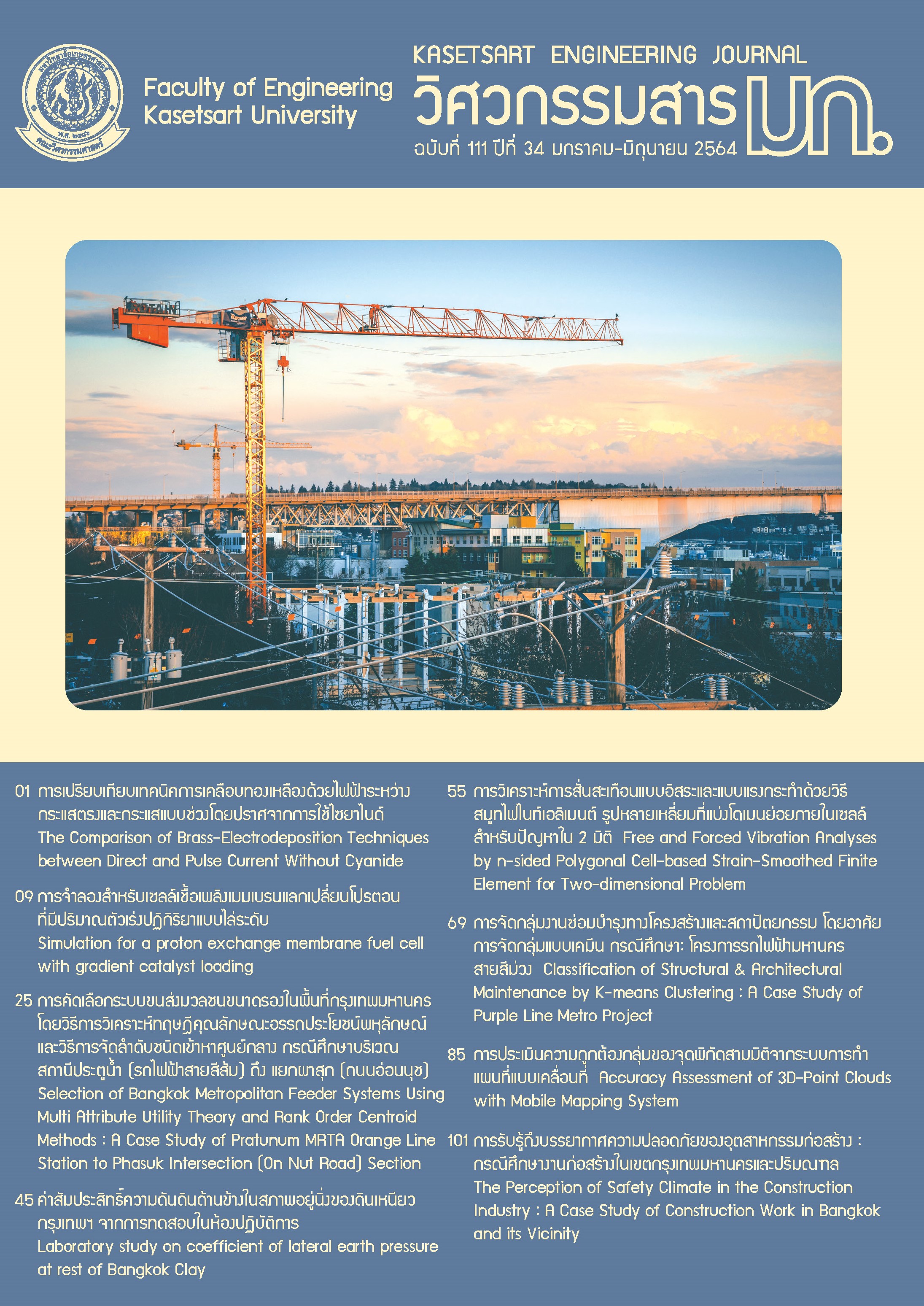Simulation for a proton exchange membrane fuel cell with gradient catalyst loading
Keywords:
Proton exchange membrane fuel cell, Serpentine flow field, Platinum distribution on the cathodeAbstract
The performance of a proton exchange membrane fuel cells depends on an electrochemical reaction on the electrode catalyst. Oxygen concentration decreases along the flow channel due to consumption during reaction. Gradient loading of catalyst along the decreased oxygen concentration is proposed in this work. This method can enhance the cell performance and save the catalyst consumption. This research aims to develop a mathematical model to predict the performance of a fuel cell. A polarization curve is used to show the cell performance. The results show that a fuel cell with a descending gradient catalyst loading provides better cell performance than that with a uniform loading. The gradient catalyst loading can give 45% catalyst consumption saving. The model results agree well with the experimental data.
References
Modekurti S, Bhattachayya D, Rengaswamy R, Narasimhan S (2010). Performance analysis of a PEM fuel cell cathode with multiple catalyst layers. Journal of Hydrogen Energy, 35: 6356-6365.
Thomas S, Zalbowitz M (1999). Fuel Cells Green Power. Los Alamos National Laboratory, New Mexico.
Xiong L, Manthiram A (2005). High performance membrane electrode assemblies with ultra-low Pt loading for proton exchange membrane fuel cells. Electrochimica Acta, 50: 3200-3204.
Zhang Y, Smirnova A, Verma A, Pitchumani R (2015). Design of a proton exchange membrane (PEM) fuel cell with variable catalyst loading. Journal of Power Sources, 291: 46-57.
Roshandel R, Ahmadi F (2013). Effects of catalyst loading gradient in catalyst layers on performance of polymer electrolyte membrane fuel cells. Renewable Energy, 50: 921-931.
Ebrahimi S, Ghorbani B, Vijayaraghavan K (2017). Optimization of catalyst distribution along PEMFC channel through a numerical two-phase model and genetic algorithm. Renewable Energy, 113: 846-854.
Wawdee P (2014). Development of Effectiveness of fuel cell. Master of Engineering, Chemical Engineering, Department of Chemical Engineering, Kasetsart University, Thailand.
Havaej P, Kermani M.J, Abdollahzadeh M, Heidary H, Moradi A (2018). A numerical modeling study on the influence of catalyst loading distribution on the performance of Polymer Electrolyte Membrane Fuel Cell. International journal of hydrogen energy, 43: 10031-10047.
Haghayegh M, Eikani M.H, Rowshanzamir S (2017). Modeling and simulation of a proton exchange membrane fuel cell using computational fluid dynamics. International Journal of Hydrogen Energy, 42: 21944-21954.
Sezgin B, Caglayan D.G, Devrim Y, Steenberg T, Eroglu I (2016). Modeling and sensitivity analysis of high temperature PEM fuel cells by using Comsol Multiphysics. International Journal of Hydrogen Energy, 41(23): 10001-10009.
Rahman M.A, Mora J.M, Chuang P.A (2017). A Computational Study of Flow Sensitivity of a PEM Fuel Cell with Multi-Parallel Flow Channels. Comsol Conference. Boston.
Das P.K, Li X, Liu Z.S (2008). A three-dimensional agglomerate model for the cathode catalyst layer of PEM fuel cells. Journal of Power Sources, 179: 186-199.
Luo X, Chen S, Xia Z, Zhang X, Yuan W, Wu Y (2019). Numerical Simulation of a New Flow Field Design with Rib Grooves for a Proton Exchange Membrane Fuel Cell with a Serpentine Flow Field. Applied Sciences, 9(22): 4863.
Downloads
Published
Issue
Section
License

This work is licensed under a Creative Commons Attribution-NonCommercial-NoDerivatives 4.0 International License.

